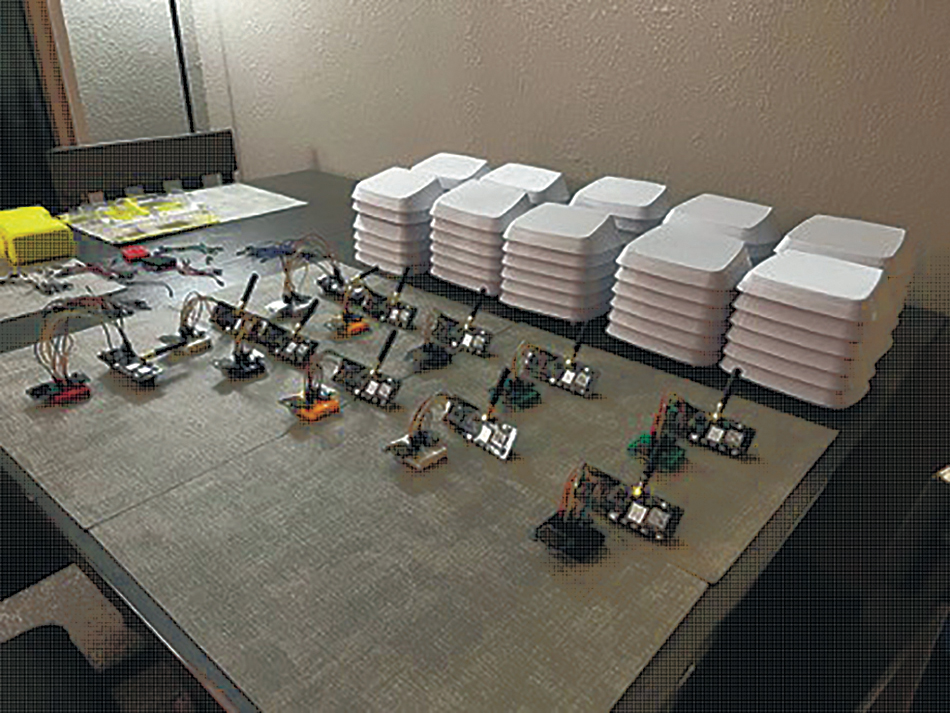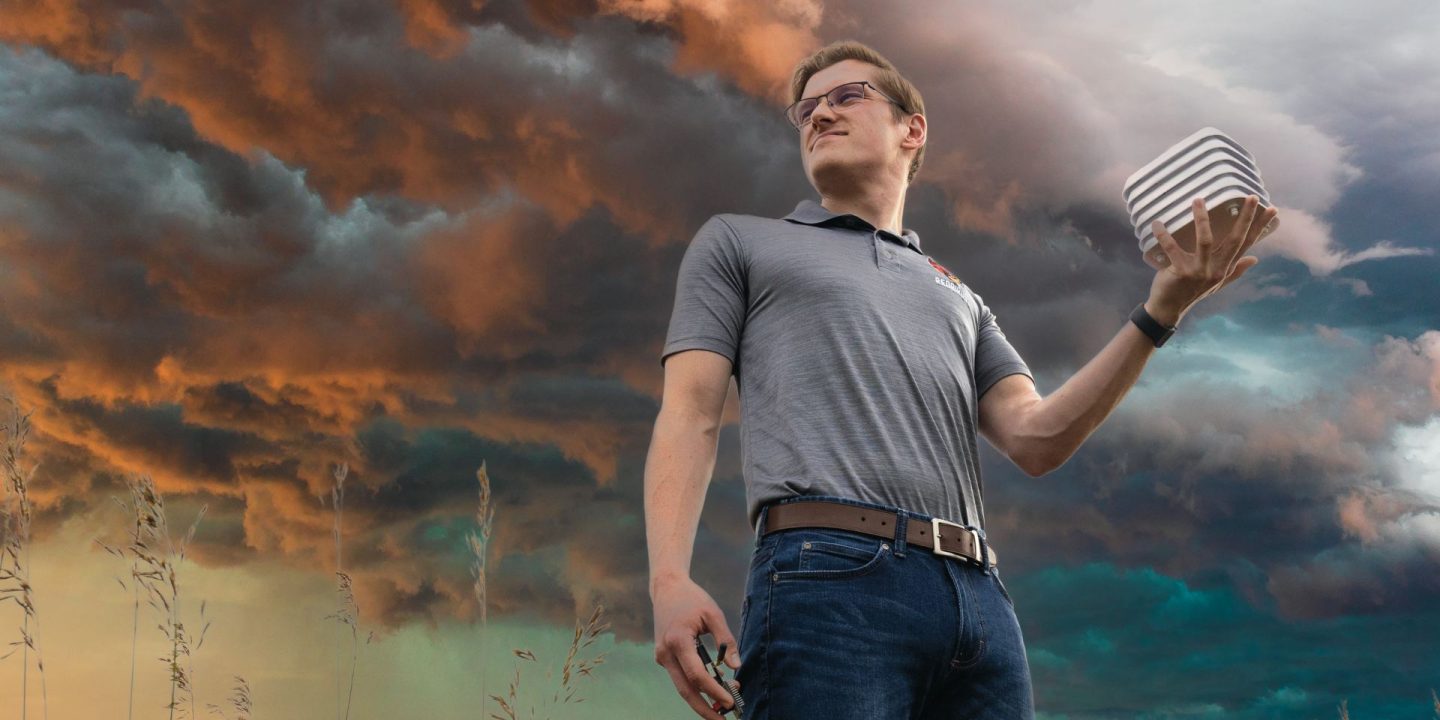TV meteorologists catch a lot of grief for faulty forecasts. Instead of grousing on his couch, Matthew Tunberg ’20, M.S. ’22, created a tool to help these prognosticators make more accurate predictions of weather patterns.
Last fall, for his master’s thesis in information systems and networks, Tunberg created a wireless mesh network of sensors, known as Internet of Things (IoT) devices, to collect weather data. He developed the low-cost network (about $500 to build) to detect changes in the weather during extreme events, like tornadoes.
Appears In“The Internet of Things is essentially a collection of small, cheap devices that work together to give us a lot more data points to make interpretations of our environment,” said Tunberg, a native of Woodstock, Illinois.
Illinois meteorologists rely mostly on information fed by two radars located in the southern and northern parts of the state, Tunberg said. His network would help cover more remote areas.
“With radar, you only have one data source. You don’t have a radar system in every single town in Illinois,” Tunberg said. “So if you are in Central Illinois or even farther away from both systems, your weather data is not going to be as accurate, because the farther out they are, the less accurate your predictions are and less frequent they update because they operate by going in a circular motion so that they cover their areas.
“The analogy I use when I explain what I’m doing to my parents is that you wouldn’t use one light bulb to light your entire house. So what I’m doing is something that’s completely different than radar, and I don’t see it as something that’s going to replace it. I see it is an enhancement.”
“So what I’m doing is something that’s completely different than radar, and I don’t see it as something that’s going to replace it. I see it is an enhancement.”
Matthew Tunberg
The goal of this project was to construct a geographical map using the IoT devices and their sensor information. From there, he could interpret the data to identify where the conditions for a tornado or another major weather event could occur.
Tunberg first thought of his weather-mapping concept during his sophomore year in Illinois State’s School of Information Technology, where he also obtained a bachelor’s degree in systems development. He worked on the project last year and saw it as a way to bridge his passions for technology and meteorology.
“I always had a fascination for meteorology when I was younger, and I took a couple of meteorology classes when I was in undergrad,” Tunberg said. “I thought if we use the power of IoT to give meteorologists more data, that would really make their predictions more accurate.”
Building the system
Tunberg created a functional design of the mesh network by August 2022 and deployed the devices last fall at a friend’s farm. He adapted existing devices that were equipped with Global Positioning System (GPS) sensors, antennae, and batteries, and added a sensor that collected the humidity, atmospheric pressure, and temperature levels.
The devices use a wireless technology called low-powered wide-area network (LoRa) to communicate with each other on a sub-gigahertz frequency. The network has a broad range and built-in resiliency, especially compared with IoT systems reliant on Wi-Fi or cell towers, which can be knocked out during extreme weather or overload when there is a heavy amount of emergency calls.
“I’m not lost if one of my devices goes haywire and gets blown up by a tornado,” Tunberg said. “With these, since they work on a lower frequency and they’re also dependent on each other and not one cell tower, they’re able to have that resiliency and repair ability of their own network. That way I can still recover my data and also give that to meteorologists for the severe weather alerts.”
Tunberg enclosed his devices in storage boxes built for free by Milner Library’s 3D printing services. “They’re completely vented around so heat doesn’t get trapped in there. They are designed so that way the wind, the pressure, the temperature easily go into the devices without letting water get in.”
Tunberg’s biggest challenge with the project was developing a software backbone that would enable the devices to communicate data between themselves and to a host device for analysis. He ended up repurposing the open source software Meshtastic to send data that could be retransmitted into his servers. There was one problem.
“Essentially they had this way of transmitting the data as small as possible,” he said. “They cram the data into these small envelopes, and I had to find a way for my server to translate them into something that is human readable because they made it so small.”
To help with the data compression analysis, Tunberg called on a friend who works as a software engineer and used the University’s cloud services. Throughout the project, Tunberg also received help from the School of Information Technology. The unit covered the cost of the equipment, and his thesis advisors—Drs. James Wolf, Jihad Qaddour, Elahe Javadi, and Sumesh Philip—guided him throughout the project.
“Matt did a fantastic job assembling a great team and taking advantage of the many technology resources available at ISU,” Wolf said. “One of the great things about ISU is the way people from all over campus are willing to work together to help our students succeed. Matt tapped into that. I hope that Matt’s success encourages other students to dream just a bit bigger.”

Test run
Building the network was one challenge, checking to see if it worked was another. He conducted a test run at his apartment in Normal.
“It’s a funny to think about it, but when I was doing my initial test, I realized I forgot to factor in negative temperatures when I was developing the program. It was getting closer to winter, and my program did not know how to handle a temperature reading that was negative.”
He did some quick troubleshooting to fix the problem, then went about testing his concept in real weather conditions.
Last October, he set up 10 devices at distances up to 5 miles apart on a friend’s farmland near Towanda. He said the experiment was a bit of a nailbiter, considering it was his first test outside of a controlled environment, but all of the devices were able to transmit the data and work together. They also provided accurate readings when checked against data collected by a weather station in Bloomington.
“I was able to confirm that the data was able to route in many ways. So in case a device got destroyed or was blown out of range because of the weather, the network was able to repair itself.”
What’s next
Tunberg graduated last December and was hired by Illinois State’s Information Security Office. He hopes one day to become a chief information officer.
In the meantime, he is working on multiple research projects. He has been testing security vulnerabilities with LoRa networks with Dr. Philip and assisting Dr. Javadi with setting up an IoT bird sound recognition network at Illinois State.
Over the summer, he planned to present his projects at academic conferences. He was also looking to incorporate the project into the school’s graduate curriculum and further develop it. He wants to integrate artificial intelligence (AI) into his network to increase the tool’s forecasting ability.
“Each device gives me a GPS location so I can see where maybe a storm front happens or maybe some unusual activity like a huge wind gust causes the pressure to drop. And I can make my own interpretations off that data. But in future cases, I was looking into building an AI model because that would help me make predictions off of these fluctuations, and with the recent changes especially with ChatGPT and other AI sources, I think it’s a real possibility.”
The better predictions he can make, the more likely his technology could one day be used by meteorologists to possibly save lives.
“I see this as something that I want to help humanity with.”

